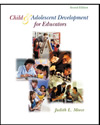 |  Child and Adolescent Development for Educators, 2/e Judith Meece,
University of North Carolina - Chapel Hill
Student Study Guide by Nancy Defrates-Densch
Cognitive Development: Information Processing and Intelligence Theories
Learning ObjectivesAfter studying this chapter, you should be able to:
| Identify the three main components of the information processing system and describe the function of each. |
 |  |  | | Give examples of shallow processing activities and deep processing activities. |
 |  |  | | Describe how information is organized and stored in the information processing system. |
 |  |  | | Discuss how information processing models relate to the theories of Piaget and Vygotsky. |
 |  |  | | Describe the development of attention in children and identify the limits and capacities of children's attention. |
 |  |  | | Describe the development of processes children and adolescents use to store and retrieve information in memory. |
 |  |  | | Discuss the role of prior knowledge in the development of the information processing system. |
 |  |  | | Define metacognition and self-regulation and describe the development of each in children. |
 |  |  | | Identify strategies based on information processing theory that teachers can use to enhance student learning. |
 |  |  | | Identify instruments currently used to assess intelligence, factors that threaten the validity of IQ scores, what IQ scores do and do not predict Also describe how IQ scores are interpreted, and the stability of IQ scores. |
 |  |  | | Discuss unitary and multidimensional views of intelligence and describe Howard Gardner's eight intelligences. |
 |  |  | | Explain how genetic and environmental factors interact to affect intellectual development and describe environmental and biological influences on intellectual development. |
 |  |  | | Discuss the history of and currently existing gaps in performance between genders and different racial and ethnic groups, and identify possible explanations for these gaps. |
 |  |  | | Describe how a multicultural education can make learning accessible to all students regardless of gender, race or ethnicity, and identify eight characteristics of multicultural schools. |
 |  |  | | Describe the positive and negative effects of television and computers on children's learning, and discuss patterns of computer use among children. |
|



 2002 McGraw-Hill Higher Education
2002 McGraw-Hill Higher Education